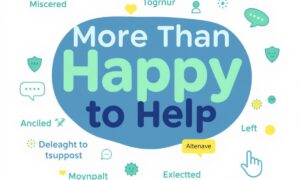The right greeting sets the tone for effective communication. You could start looking for alternatives other than “hello everyone,” so your messages become more engaging and memorable.
Be it your meeting, a team mail, or when you are starting a presentation, a good greeting creates a connection.
Diversifying your salutations could demonstrate such thoughtfulness as help not to sound stale or repetitive in communications..
Now, let’s look at several warm, professional, and creative group addresses to suit the different contexts.
Dear Team Members
Assemble your team members. Use the salutation that instills a sense of belonging and creates respect in the workplace setting.
This approach is quite commendable for formal correspondence with a friendly touch. It regards everyone as part of the end product or result, thereby enhancing team spirit and collaboration.
This salutation is extremely effective even within emails dealing with major matters or sending messages across departments. “Dear Team Members” strikes a balance between professionalism and warmth that allows the recipient to feel appreciated and included.
Example: Dear Team Members, I’m coming to you regarding the upcoming quarter planning session.
READ MORE: https://travelloverage.com/ways-to-say-circling-back-in-an-email/
Greetings Everyone
Cordial though somewhat more formal, greeting a group of colleagues with “Greetings Everyone” is an equally usable salutation for just about any context from emails to meeting opens.
It has respect without being overly formal while remaining within an approachable tone that makes everyone feel as though they belong.
Thus, “Greetings Everyone” adds a refined touch to your communication that doesn’t feel stuffy or too pretentious. This kind of greeting is very useful when addressing a mixed audience in terms of rank or knowledge.
Eample: Greetings everyone, and thank you for attending our workshop this Friday on product development.
Hello All
Hello Group provides a very concise way to refer to any size or variety of group.
Quite straightforward, and warmth-infused makes it fit into both the formal and casual bracket without fail. Just right to quickly get to the point but still acknowledge everyone.
Brings together people as a collective and works well for the efficient but friendly approach.
Such a universal salutation can be extended to any form of communication-from email to video calls.
Example: Hi All, the revised schedule for next month’s events is attached.
Hi Everyone
“Hi Everyone” creates the atmosphere of an instant welcome due to its casual friendliness.
This salutation is very useful in a team meeting, informal email, and any space for collaboration where relationship building is key.
It sets an environment where a person would feel relaxed talking openly and sharing ideas. “Hi Everyone” shows others that you are easy to approach and open to conversation, creating the perfect weather for inclusion.
Use this greeting when you truly want to encourage the atmosphere and participation.
Example: Hi Everyone, I’d love to hear any thoughts about the new marketing campaign.
Hey Team
“Hey Team” creates an instant sense of camaraderie and collegiality. In organizations where team members know one another well enough, this is probably the spirit communication for breaking the ice.
It instantly casts a feeling of being part of something and common purpose that might be very energizing for the group.
“Hey Team” would also work well for motivational communications or when trying to rally people behind a common goal.
This kind of openness paves the way to lean and open communications among team members.
Example: Hey Team, wonderful challenge up ahead for us this quarter!
Find More Words!
Having a wider vocabulary of greetings will create more engaging, personalized communications. Greeting alternatives allow you to match the tone to a specific audience or purpose.
The interesting little greetings make a difference in your messages and can show some company culture or team spirit.
Exploring the different forms of greeting is an expression of your communication skills and attention to detail.
Variety in greetings sanitizes boredom and lends some fresh energy to systems of regular communication that might otherwise be ignored.
Example: Awesome marketing people, you guys inspire the whole organization with your creativity!
Good Morning All
Thus, “Good Morning All”, is a greeting added, making it time-specific. Being faithful to the time of day, it acknowledges the presence of a current moment even in written forms.
Well, this could be an excellent formula for adopting it in a morning meeting; the early email would make sense to initiate communication on starting the day.
The technique thus speaks of tremendous energy and optimism, putting it on the right track as far as days go.
This could be adapted from good morning all to good afternoon all or good evening all depending on when the communication is relayed.
Example: Good Morning All, I hope you’re starting your day with lots of energy and inspiration.
Salutations Everyone
This greeting is a little bit formal and quite different from the common ones: “Salutations Everyone”. It has a certain almost elegant form that’s much better suited for a professional affair where an impression counts.
It is a way of showing respect, yet is friendly and inclusive, making it sound as if it were meant for everyone. “Salutations Everyone” can add personality into your communication style and shows attention to language: it is very well-suited for the delivery of an important announcement or addressing large groups in a memorable way.
Example: Salutations Everyone, it’s my pleasure to announce our company’s newest partnership.
Howdy Team
“Howdy Team” offers an informal warmth with a regional charm. Very genial, it makes for a conversational tenor that can put anyone immediately at ease.
It works particularly well for creative atmospheres or teams with an informal bent. Junctures of “Howdy Team” allow for personality and breaking the ice in unfamiliar groups or with collaborative projects.
This greeting indicates accessibility and allows for free-flowing communications among team members in a more casual tone.
Example: Howdy Team, let’s brainstorm some innovative solutions for our client’s challenges.
Warm Greetings All
“Warm Greetings All” introduces a real friendliness and caring touch to the communicative action. In other words, this salutation adds emotional value to an actually well-meaning communication so that recipients feel wanted and appreciated.
It enhances the communication if it refers to mending relationships after a time of separation or when the topic is sensitive.
In other words, “Warm Greetings All” establishes that warm emotional tone, making conversation easier about hard things or things worth celebrating.
This greeting shows a sense of consideration and thoughtfulness for the audience’s feelings.
Example: Warm greeting to all; I’m so happy to share the excellent achievements of our team this month.
Hey Everyone
“Hey Everybody” induces a very casual and approachable atmosphere in group communication. It is an appropriate salutation for soliciting input while making everyone feel equal in listening to your messages.
This could either be brainstorming, giving informal updates, or doing a team-building act.
It indicates that you’re going to be very direct and casual in your communication and not so much formal about it.
The greeting helps reduce the perceived barriers from leadership to their team members in organizational settings.
Example: Hey Everybody, I want your participation in figuring out how to make our weekly meetings better.
Good Day Team
“Good Day Team” – This greeting is both professional and warm, transcending cultures. In fact, it is slightly formal yet friendly so it can be used in dynamic business environments.
It suits well when interacting with an international colleague or more so with multicultural environments. “Good Day Team” encompasses respect while still remaining accessible and inclusive.
This greeting addresses the whole group and sets a positive tone for the communication that follows.
Example: “Good Day Team, I’m pleased to share updates on our international expansion efforts.” “Good Day Team” is that salutation in which you find professionalism combined with warmth. It works in greeting across cultures. This is a slightly formal yet friendly salutation apt for all kinds of business settings; very appropriate when one is going to communicate with an international colleague or in a more multicultural environment.
Example: “Good Day Team”, I am happy to deliver the updates on our international expansion efforts.
Hi Team Members
The above statement, “Hi Team Members,” strikes a good balance between warmth of approach and offsetting a strong sense of professionalism.
This greeting recognizes the roles of the people concerned with a friendly note. It works in cross-functional groups or when you want to stress collective identity.
“Hi Team members” also gets those communication addresses to reinforce the social structure whilst keeping it warm and personal.
It suits particularly well to use in the case of newly formed teams and during the onboarding process.
Example: Hi team members! Welcome to our newly formed product development group.
Greetings All
All Greetings” can serve as a salutation that is really the one and only summary of any formal or informal context.
With the formula of being very professional and friendly at the same time, it is usable for any communications.
This should include all felicity with the balance that does not make it too familiar or too cold. It is one of the best ways to handle a larger crowd where the audience is comprised of people from different levels of familiarity or rank.
Especially very useful when there’s confusion on asking what kind of formality the speech should be.
Example: Greetings All, I wanted to give you an update on our project timeline.
FAQ’s
When should I use formal versus casual greetings?
With formal greetings, think about communications that are more official, senior leadership, or external parties involved; casual greetings are best when used with familiar colleagues.
How can I make my greeting more inclusive?
Instead of using gendered terms, try referring to “all,” “everyone,” or by using “team,” ensuring every recipient feels acknowledged.
Should greetings be time-of-day dependant in emails?
Yes, even more so if you intend for the email to be read soon after sending, but consider time zones for your recipient.
Should I switch around my greetings or be consistent with one form of salutation?
Switching greetings maintains the freshness of communication, whereas if one type of greeting is used consistently it would help shape your personal style or brand.
How prominent is the greeting in the overall importance of message contents?
The greeting establishes the very first impression and influences the degree to which readers are open to your actual message contents, therefore making it relatively more important.
Conclusion
You would enrich your creativity in addressing groups and boost your communication effectiveness, as well as contribute towards apparent improvement in relationships.
The particular salutation you choose goes beyond just the present moment, setting the tone for the rest of what follows.
Therefore, it becomes one of the most vital elements in successful communication. Then, in a sense, you would be able to vary your salutations according to different contexts, audiences, and purposes, which shows also having social awareness and language proficiency.
Remember, the best greeting is the one that is matched with your voice while properly acknowledging your audience.
Every context requires a different greeting; this is why you should build a repertoire of salutations, leaving you room to maneuver as a communicator
Finally, whether you’re sending a quick update, leading an important meeting, or writing a formal announcement, your choice of greeting counts.
The small touch of creating little meaningful greetings can perform major miracles in the receipt and retention of your message.
Consider your organization’s culture and communication norms when settling on how to address groups.

I’m Irfan, an experienced SEO content and SEO specialist with 2 years of expertise, currently contributing to Al Jazeera News Website.












